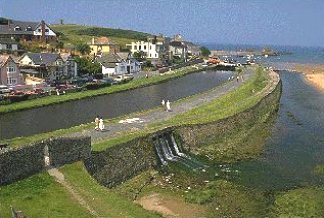


Near Bude, EX23 8LQ
Tel: (0300) 1234202
Email: Countryside@cormacltd.co.uk
Web: www.bude-canal.co.uk
Web: www.bude-canal-trust.co.uk
Web: www.cornwall.gov.uk/environment-and-planning/parks-and-open-spaces/bude-canal-and-marshes
A wet way to nowhere
The Bude Canal was designed by Cornish engineer John Edyvean in 1774 and built in 1826 primarily to transport sea sand, rich in lime, to farms in North Cornwall and West Devon, where the soil was poor. The canal for the first two miles would be a broad canal, capable of taking vessels of 40-50 tons. At the seaward entrance, a sea lock would be constructed to allow sailing vessels of 70-100 tons to be admitted to the basin for trading. In 1835 the Sea Lock was enlarged to its current dimensions to take larger seagoing vessels of up to 300 tons. The entire canal extended to about thirty miles.
Wharf Area
Sea-going vessels using the sea lock with a depth of fifteen feet on an average spring tide brought coastal cargoes of limestone coal and general merchandise. The lock is one of the last working sea locks in the country, and well worth a visit. On the higher wharf, grain and cargo were stored in Pethericks Building, which has sadly since been demolished, although one building still remains which has been converted into flats. At the far end of the wharf, lime kilns functioned, the remains of one being visible to this day, also a foundry and a timber mill which later became a steam laundry and has now been converted into four houses. In the same vicinity, boat building and repairs took place, with boats travelling to and from the sea via the sea locks, and up the canal past Falcon Bridge, then a swing bridge, being replaced in recent years by the County Council. The building which is now "The Brasserie", the Bark House and the Museum (which used to be the blacksmith's shop) are three of the original buildings on the wharf. Falcon Bridge is a road bridge that replaced a swing bridge in the 1960's, significantly reducing headroom for boats. It's located near the Falcon Hotel and allows passage to the Upper Basin.
Helebridge
The first part of the Bude Canal, from the sea locks to Helebridge, is a traditional barge lock canal, and is still navigable, although the lock gates at Rodds Bridge and Whalesborough have long since been replaced with concrete spillways. A level canal-side walk, either to Helebridge and back, or travelling via Upton or Widemouth Bay, back to Bude, takes in not only the canal, but also the nature reserve, and a wide variety of differing wildlife habitat. At Helebridge itself, after crossing the A39, one can see the old wharf area, and the restored barge workshop, where the local council have set up a pleasant picnic area. The Weir Bistro also offers welcome refreshments.
Inland
At Helebridge the canal changes, and instead of locks, the canal traverses its first hill up an inclined plane. The canal tub boats, with wheels fitted to their undersides, were pulled up this first plane for a distance of 836 feet - a rise of 120 feet. The canal then travelled through Marhamchurch, to the much larger inclined plane at Hobbacott, which is accessible along a public footpath from the viewing point on the A3072 at Hobbacott Down, between Red Post and Stratton. Continuing on to Red Post the canal branches off towards Launceston, following the Tamar Valley, with the other branch heading towards the "port" town of Holsworthy. The Holsworthy leg of the canal also has a branch off towards Tamar Lake, which was originally built to feed the canal with water, and some parts of this are well worth a visit, particularly the old "Bude Aqueduct" where there is an interpretation centre at Virworthy Wharf. The Launceston branch nearly reached the navigable upper reaches of the Tamar and it can be imagined that this could have been seen either as a short cut for shipping from Wales to the English Channel or an attempt to set Cornwall adrift into the Atlantic! In either event the Canal is a fine piece of industrial heritage and further details can be found in the Bude Museum, at the Bude Visitor Centre.
Very soon after the arrival of the railway, in 1901, the Canal was forced to close because of a loss of trade.
In 2000 the sea lock gates on the canal were replaced at a cost of £500,000.
On Monday 10th March 2008, a powerful storm wrenched one of the lock gates off its fixings. Contractors removed the gate the following morning, and four-tonne concrete pipes were placed in the canal basin to dissipate the power of waves coming in from the sea.
Runs south from the south-western edge of the town.
Opening TimesAll Year Admission Free |
Bude Tamar Lakes Country Park Bude Visitor Centre Bude-Stratton Museum